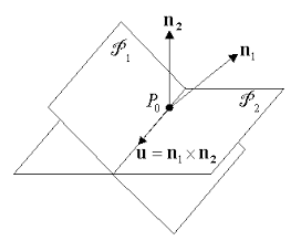
An angle between the plane, $x+y+z=5$ and the line of intersection of the planes, $3x+4y+z-1=0\,\,and\,5x+8y+2z+14=0$, is
(a) ${{\cos }^{-1}}\left( \dfrac{3}{\sqrt{17}} \right)$
(b) ${{\cos }^{-1}}\left( \sqrt{\dfrac{3}{17}} \right)$\[\]
(c) \[{{\sin }^{-1}}\left( \dfrac{3}{\sqrt{17}} \right)\]
(d) ${{\sin }^{-1}}\left( \sqrt{\dfrac{3}{17}} \right)$
Answer
595.5k+ views
Hint: Find the line of intersection of planes. Then by using normal concept find angle between line given by equation $ai+bj+ck$ and $Ax+By+Cz=D$ plane equation is given by the:
Let x be the angle between them.
$\sin x=\dfrac{\left| \left( Ai+Bj+Ck \right)\times \left( ai+bj+ck \right) \right|}{\sqrt{{{A}^{2}}+{{B}^{2}}+{{C}^{2}}}\times \sqrt{{{a}^{2}}+{{b}^{2}}+{{c}^{2}}}}$
Complete step-by-step solution -
Similar to analogy, if 2 lines are not parallel and not coincident then they must be intersected at only one point. If 2 planes are neither coincident nor parallel, they must cut each other through a line of intersection. The direction of that line is found by cross product of their normal respectively. In the equation of the plane if we replace x,y,z, with I,j,k and remove the constant then we get the direction of normal. If we do that twice here and then we do cross product of those we get direction of the line of intersection. As this line will be perpendicular to both the normal, we get this condition of cross product.
Rough image of 2 intersecting planes can be given as:

Direction of line of intersection:
Plane equation-1 is given as $3x+4y+z-1=0$
Plane equation-2 is given as $5x+8y+2z+14=0$
Direction of line of intersection
\[\begin{align}
& \left( 3i+4j+k \right)\times \left( 5i+4j+2k \right) \\
& =\left| \begin{matrix}
i & j & k \\
3 & 4 & 1 \\
5 & 8 & 2 \\
\end{matrix} \right| \\
\end{align}\]
\[=i\left( 8-8 \right)-j\left( 6-5 \right)+k\left( 24-20 \right)=-j+4k\]
By basic knowledge of planes, the angle between the plane with equation $Ax+By+Cz=D$ and line with direction $ai+bj+ck$ is given by x= angle.
$\sin x=\dfrac{\left| \left( Ai+Bj+Ck \right)\times \left( ai+bj+ck \right) \right|}{\sqrt{{{A}^{2}}+{{B}^{2}}+{{C}^{2}}}\times \sqrt{{{a}^{2}}+{{b}^{2}}+{{c}^{2}}}}$
Given plane equation in question is $x+y+z=5$, So the value:
$A=1,\,B=1,\,c=1\,\,\,,\,\,\,\,a=0,b=-1,c=4$
By substituting these into the equation, we get as follow:
$\sin x=\left| \dfrac{\left( i+j+k \right)\times \left( -i+4k \right)}{\sqrt{3}\times \sqrt{17}} \right|=\dfrac{3}{\sqrt{3}\sqrt{17}}$
By simplifying the above equation, we get as follow:
\[x={{\sin }^{-1}}\dfrac{3}{\sqrt{3}\sqrt{17}}\]
Therefore option (d) is the correct answer.
Note: Be careful while calculating direction of line of intersection as it may affect the whole result. Always remember the cross product of two normal give a line parallel to the line of intersection of both the planes. So directions of 2 parallel lines are equal. This analogy is very crucial.
Let x be the angle between them.
$\sin x=\dfrac{\left| \left( Ai+Bj+Ck \right)\times \left( ai+bj+ck \right) \right|}{\sqrt{{{A}^{2}}+{{B}^{2}}+{{C}^{2}}}\times \sqrt{{{a}^{2}}+{{b}^{2}}+{{c}^{2}}}}$
Complete step-by-step solution -
Similar to analogy, if 2 lines are not parallel and not coincident then they must be intersected at only one point. If 2 planes are neither coincident nor parallel, they must cut each other through a line of intersection. The direction of that line is found by cross product of their normal respectively. In the equation of the plane if we replace x,y,z, with I,j,k and remove the constant then we get the direction of normal. If we do that twice here and then we do cross product of those we get direction of the line of intersection. As this line will be perpendicular to both the normal, we get this condition of cross product.
Rough image of 2 intersecting planes can be given as:

Direction of line of intersection:
Plane equation-1 is given as $3x+4y+z-1=0$
Plane equation-2 is given as $5x+8y+2z+14=0$
Direction of line of intersection
\[\begin{align}
& \left( 3i+4j+k \right)\times \left( 5i+4j+2k \right) \\
& =\left| \begin{matrix}
i & j & k \\
3 & 4 & 1 \\
5 & 8 & 2 \\
\end{matrix} \right| \\
\end{align}\]
\[=i\left( 8-8 \right)-j\left( 6-5 \right)+k\left( 24-20 \right)=-j+4k\]
By basic knowledge of planes, the angle between the plane with equation $Ax+By+Cz=D$ and line with direction $ai+bj+ck$ is given by x= angle.
$\sin x=\dfrac{\left| \left( Ai+Bj+Ck \right)\times \left( ai+bj+ck \right) \right|}{\sqrt{{{A}^{2}}+{{B}^{2}}+{{C}^{2}}}\times \sqrt{{{a}^{2}}+{{b}^{2}}+{{c}^{2}}}}$
Given plane equation in question is $x+y+z=5$, So the value:
$A=1,\,B=1,\,c=1\,\,\,,\,\,\,\,a=0,b=-1,c=4$
By substituting these into the equation, we get as follow:
$\sin x=\left| \dfrac{\left( i+j+k \right)\times \left( -i+4k \right)}{\sqrt{3}\times \sqrt{17}} \right|=\dfrac{3}{\sqrt{3}\sqrt{17}}$
By simplifying the above equation, we get as follow:
\[x={{\sin }^{-1}}\dfrac{3}{\sqrt{3}\sqrt{17}}\]
Therefore option (d) is the correct answer.
Note: Be careful while calculating direction of line of intersection as it may affect the whole result. Always remember the cross product of two normal give a line parallel to the line of intersection of both the planes. So directions of 2 parallel lines are equal. This analogy is very crucial.
Recently Updated Pages
Master Class 12 Business Studies: Engaging Questions & Answers for Success

Master Class 12 Economics: Engaging Questions & Answers for Success

Master Class 12 English: Engaging Questions & Answers for Success

Master Class 12 Maths: Engaging Questions & Answers for Success

Master Class 12 Social Science: Engaging Questions & Answers for Success

Master Class 12 Chemistry: Engaging Questions & Answers for Success

Trending doubts
What are the major means of transport Explain each class 12 social science CBSE

Which are the Top 10 Largest Countries of the World?

Draw a labelled sketch of the human eye class 12 physics CBSE

Explain sex determination in humans with line diag class 12 biology CBSE

The pH of the pancreatic juice is A 64 B 86 C 120 D class 12 biology CBSE

Give 10 examples of unisexual and bisexual flowers




